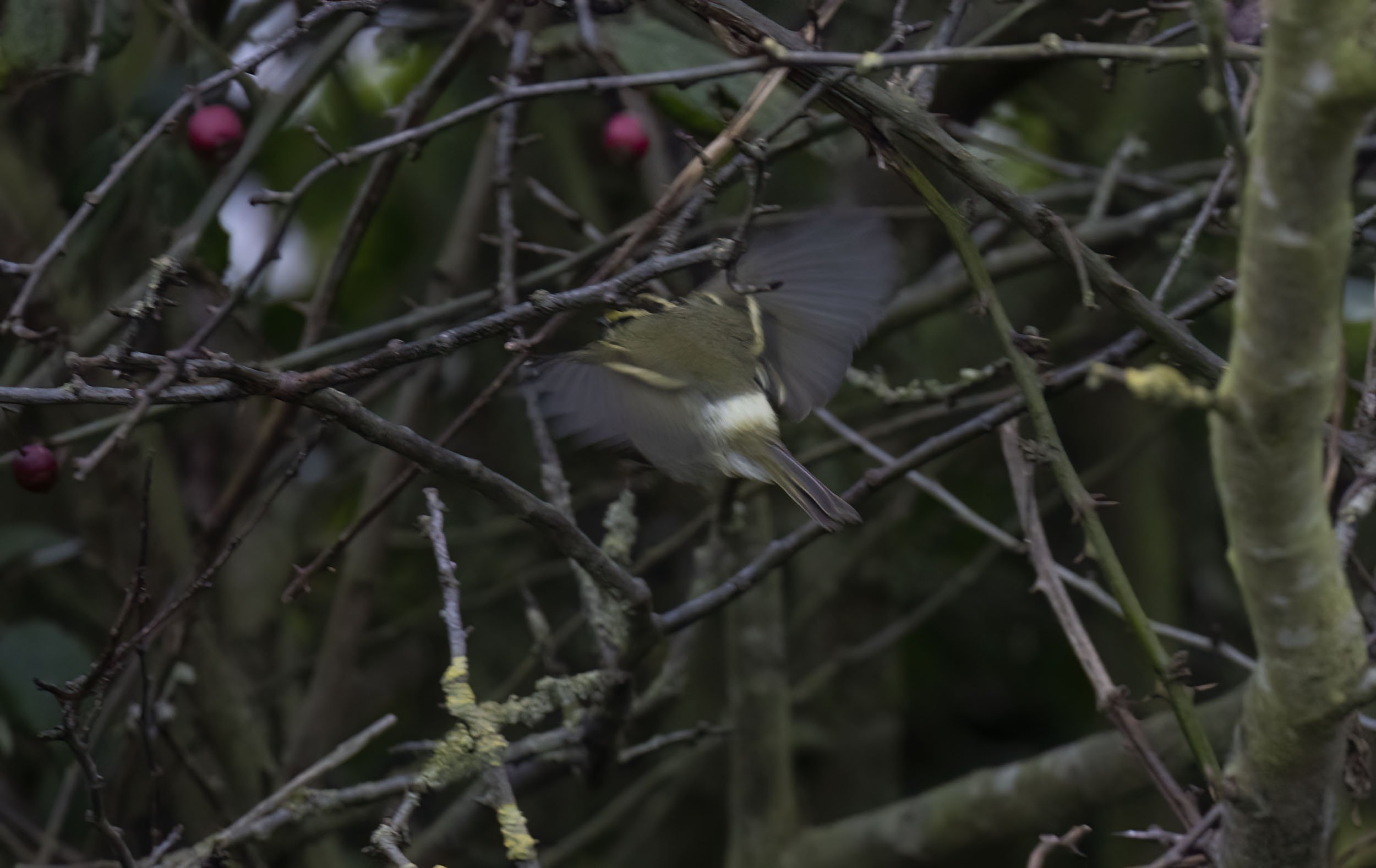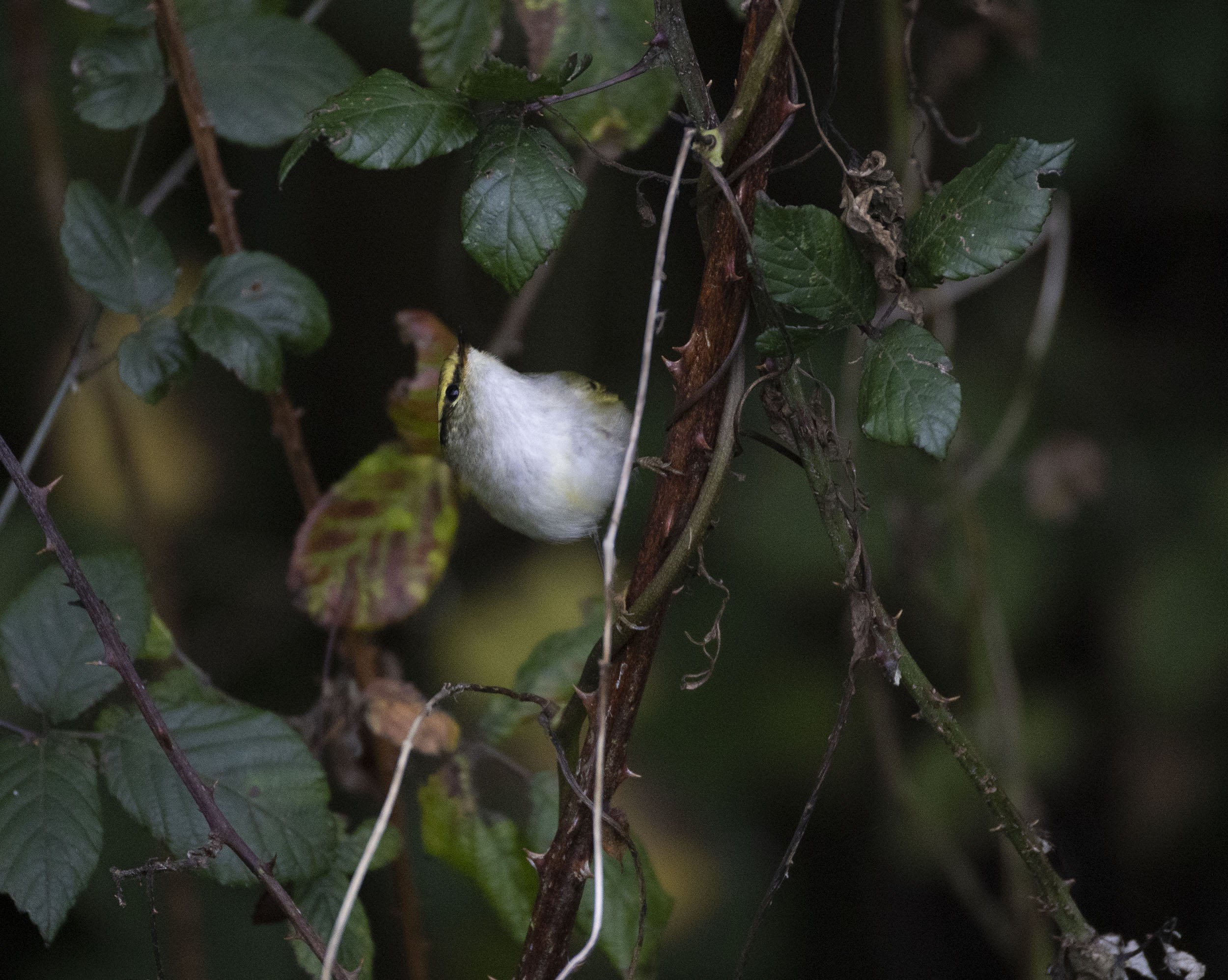A Pallas’s Leaf warbler and unexpected Pallid Swift - November 4th a bonus late autumn day at Donna Nook
On Sunday November 3rd a Pallas’s Warbler was reported at Stonebridge car park Donna Nook. Not a great surprise given the good autumn for eastern vagrants but every one is a treat for the eyes and a bird not to be missed particularly when it is only 42 miles away. Thus, Monday saw me heading to said car park in the hope of laying eyes on this little beauty and maybe, just maybe getting some photos but the weather was pretty dire with thick dark clouds making it appear more like dusk than midday. Located fairly quickly it fed in a large willow and small hawthorns throughout the day but ISO 10,000 was needed to get even a slow shutter speed and stopping it in mid hover was a total impossibility. But what a gem and a great addition to the autumn’s sightings.
Initially frustrating to say the least nearly every shot was out of focus or the bird pattly hidden by branches and leaves
Named after the German explorer/naturalist Peter Simon Pallas who collected the first specimen in the area of Transbaikalia, near the Mongolian border, during the late 1700s, the Pallas’ Warbler or formerly Pallas’ Barred Willow Warbler and subsequently Pallas’s Leaf Warbler is a jewel the size of a Goldcrest or matchbox (younger readers look up matchbox on the internet) and weighing just 4-7gms the same as a new pencil. Breeding no closer than 3000 miles to the east of the UK in eastern Asia they generally move south to winter in southern China and north-eastern Indochina but late autumn high-pressure systems sitting over Central Asia bring a few birds to Western Europe in most autumns.
The first for Britain was obtained, shot, at Cley, one of my old UEA haunts, on October 31st 1896 as described below by the great DIMW in his superb tome Beguiled by Birds. It was also Ian who coined the phrase the seven striped sprite for Pallas’s Warbler a term well used.
From the superb Beguiles by Birds by the late great Ian (DIM) Wallace
A must read for British birders
With a total of just three records prior to 1958 this was a mega rare bird but the first of a series of late autumn influxes occurred in 1968 when 18 birds occurred. That autumn saw the first two records for Lincolnshire when single birds were trapped simultaneously at Anderby Creek and Gibraltar Point on October 19th. Further big autumns saw 29 recorded in 1975 and 33 in 1981 with an amazing 127 in autumn 1982.
I think everyone remembers their first Pallas’s Warbler and rightly so, it is usually a heart stopping moment when you see all those stripes and the first time it hovers that glowing lemon rump. My first was seen at Saltfleet Haven on October 30th 1976 but was slightly reduced in impact by the metal leg iron placed on it the previous day. It fed in dead elders and buckthorn in the dunes and I went back the following day for seconds and even managed to tale a decent picture on the old Kodachrome 64 slide with my Nikon F301 and Sigma APO 400 5.6 manual focus lens. My first found bird followed three years later at Rimac on October 27th 1979 and in the magical autumn of 1982 I managed to see no less than five birds. October 21st 1988 was a Pallas’s red-letter day when we found three birds at Pyes’ Hall and by the end of 2023 I had seen a pretty amazing 62 individuals in Britain compared to 196 Yellow-browed Warblers of which I have even had seven on my local patch at Barton.
Pallas’s Warbler Saltfleet Haven October 1976
If Goldcrests are very active and Yellow-browed Warblers extremely active then Pallas’s Warblers are hyperactive and add to this a willow that seemed to be open but still had several million leaves and branches and the dullest of days getting any decent images of this year’s jewel was fraught with problems but all in all I was pleased to get some shots reflecting its character.
Every Pallas’s Warbler deserves a concerted effort and a day of anyone’s life.
even bramble briars were against me
a 250th of a second is not a lot of use for action shots
Given the conditions this image was not too bad
Escaping the willow’s branches and leaves but with a rather nasty white sky background
getting all the stripes in one image is a tricky business
a pretty typical view in the brambles
and a peepo shot
foraging for insects under the bramble leaves was more frequent in the afternoon
a bright light in the darkness
its that who you looking at shot
had to make do with a lemon rump shot in an almost still moment rather than the desired hovering shot
As the afternoon drew to a close at 15:20 I was sat in the car to make a phone call but as is the case it seems with so much bird finding I needed a call back so I got out to have a last look around when a couple walked up to the car next to mine and asked what I had been seeing concluding with we have just seen a Swift, well we think it was a Swift but its a bit late! Rapid walk with 100-500 in the increasing gloom and there is a Swift drifting over the dunes - its got to be a Pallid or so we assume in fact what was almost the first British Record was just up the coast at North Cotes on November 4th 1975 being seen the following day just to the south at Rimac : I could see very little with the bins so took some images and fortunately it flew right over my head a couple of times but I was on ISO 10000 to get a reasonable shutter speed and the grey sky was almost blown out trying to keep some detail int he bird and not ending up with a set of silhouettes; A quick look at the screen on the camera quickly confirmed it was indeed a juvenile Pallid Swift but after about ten minutes I lost sight of it and assumed it may have drifted off south. Images below - to say they are record shots is an exaggeration but at least they show the key features. What next? I am surely due a Hume’s but maybe could the nana finally fall in Lincs.
terrible images of the juvenile Pallid Swift in the late afternoon gloom at Donna Nook they look almost monochrome because there was no light in the gathering gloom
appeared to be feeding well but still moved off








































